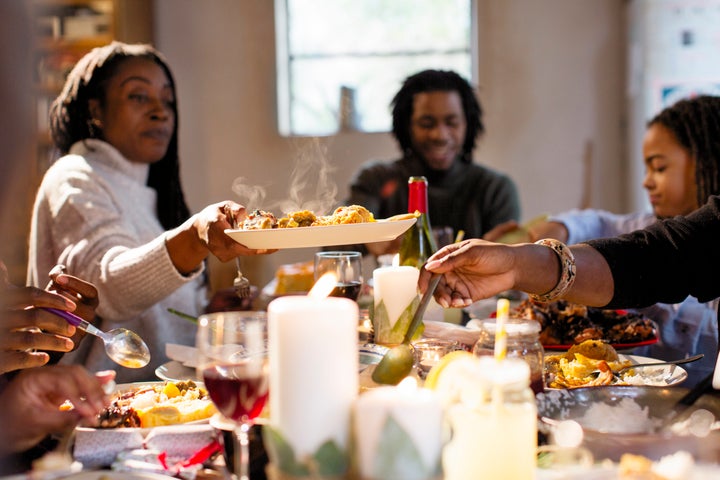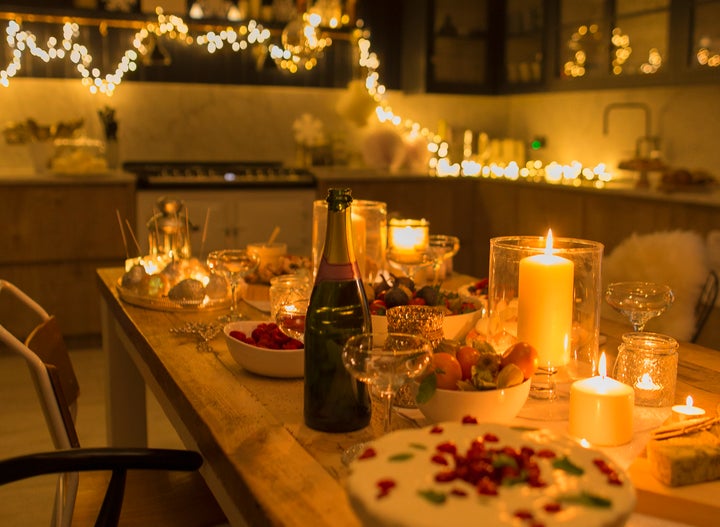Not to smash anyone’s Yuletide joy with a sledgehammer, but your Christmas festivities aren’t so good for the planet.
Aside from all that non-recyclable wrapping paper and gifts for twice-removed relatives you see once a year, there’s the food. According to 2015 research conducted by Unilever, the season sees 4.2 million lunches wasted across the UK - the equivalent of 263,000 turkeys, 17.2million Brussels sprouts, 11.9 million carrots, 11.3 million roast potatoes, 7.5 million mince pies and 740,000 slices of Christmas pudding.
While you obviously need this time to focus on which flavour of Quality Street mingle the best when eaten in rapid succession, there are some straightforward steps you can take to make your December 25th meal that bit more green.

What to eat
Jen Gale, a Wiltshire-based sustainable living specialist, tried to have a more sustainable Christmas dinner last year, along with her husband and two kids. “We didn’t do starters, because everyone gets so stuffed and we wanted to avoid food waste,” she tells HuffPost UK. “We ordered a free-range, organic turkey from the local butcher, to reduce food miles, and asked for the giblets, to make a stock with, along with the carcass.”
When it came to dessert, they went for a Christmas pudding, steamed in the slow cooker and made with flour, spices, dried fruits and nuts bought from online plastic-free shop, Plastic-Free Pantry. For veg, they ordered an extra large box from Riverford Organic, meaning that everything was British produce grown with the natural swing of the seasons.
If you are doing a traditional bird, you want “a pound per person, including the bone,” according to Andrei Lussmann, MD of the sustainable restaurant group, Lussmanns, and a founding member of the Sustainable Restaurant Association.
He also says that, if you’re serving a shellfish starter, it’s a good shout to make sure it’s all MSC-certified, so that you’re supporting sustainable fishing practices.
For Doug McMaster, founder of zero waste restaurant, SILO, the key thing to focus on is farming practices. “The highest thing on my list would be supporting sustainable agriculture,” he tells HuffPost UK. “You can do this by looking to get your vegetables, dairy products and meat from local farmers, rather than things that may have been grown or reared using intensive farming methods, which are bad for soil quality.”
After that, he recommends cutting down on the amount of meat on the table. “I’m not a vegetarian, but my mum is, and I do love the idea of a vegetarian Christmas dinner. I’m a big fan of Middle Eastern food, and I find that it doesn’t usually require loads of prep.” This year, he’s thinking of a spiced soup made from locally-sourced veg, followed by a Lebanese moussaka and rounded off with a Christmas pudding, served with sumac-laced custard.
Some thoughts on drinks
Think about what you can re-use. If you’ve picked some sage for your stuffing, cut and keep the stalks to infuse into a syrup, says McMaster. You can then add this into a cocktail. Just “simmer your stalks with a mix of two parts water, one part sugar, until withered and you’ve extracted all of the flavour.” You could stir this up with a little gin, blood orange juice and a splash of cava, or with fizzy water and a dash of fresh lemon juice, for a booze-free take.

Table settings
If your festive table ultimately ends in an exploded crackers, reams of tissue paper and paper jokes massacre, maybe think about how you can strip this stuff back, too. Gale found that reuseable crackers, that you fill with your own gift, work a charm. “I added a chocolate coin, and then my son sat with a joke book and wrote out funnies that were personalised to each person at the table,” she says. Plastic-free, these will make a dent in your accumulative Yuletide waste, if you bring them out year after year. She also recommends using cloth napkins, rather than paper types that end up in the bin.
For decoration, taking fallen leaves out of the garden and dipping them in gold paint looks great, as do pine cones that you can collect from outside, or evergreens from the garden. Try bundling a starched, white napkin with a gold-dipped leaf and a knife and fork, and wrapping them with twine, for a pretty, rustic look.

How to handle your leftovers
You will buy, cook and have too much food. This is the natural order of things at Christmas. If you do go for a bird, do something more exciting with the remains than a turkey butty. “You could make a schnitzel, by coating pieces of meat in breadcrumbs and egg yolk and then pan frying,” says Lussmann. “Or break bits of it with leftover veg and potatoes and mould into little cakes, again, to pan fry.” (You can also do this, minus the meat, for a classic bubble and squeak).
Don’t forget to also use the carcass: boil the bones down into a stock, with some peppercorns, carrots and onion, before leaving to cool and pouring into ice cube trays. Freeze, and you’ve got ready-made stock cubes. Lussmann also recommends collecting any fat that runs off any cooked sausages, goose or turkey to use in place of olive oil or butter in cooking.
Is this all going to bankrupt me?
This stuff is lovely, sure. But is it going to cost a pile of £20 notes bigger than your Boxing Day hangover? “There’s no two ways about it, an organic, free range bird is more expensive than a factory farmed one,” says Gale. “But we use every last scrap and don’t go mad on presents, so, for us, it evens out.” Of course, responsibly fished seafood and organic veg are more expensive than their counterparts, but there are steps you can take to lesson the blow. Bulk-buying sustainable veg, reducing the amount of meat you eat and simplifying the menu to avoid waste, all help you to reign it in.